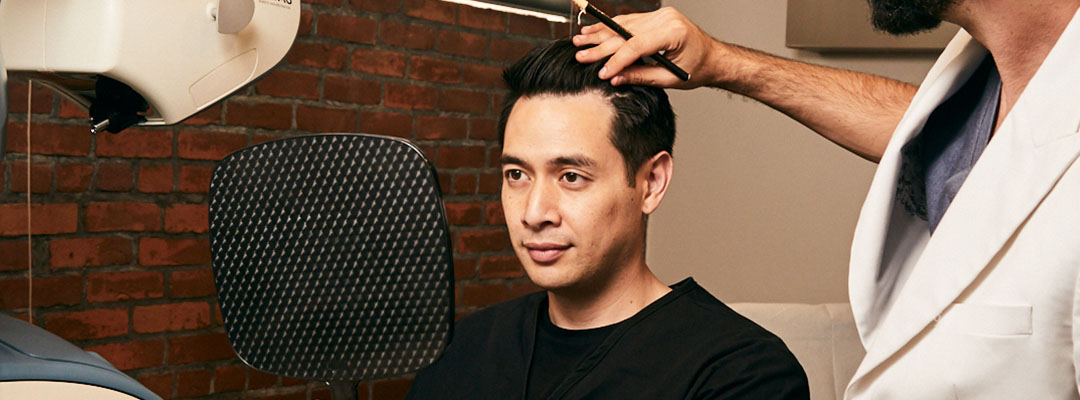
Diferencia entre restauración capilar y trasplante capilar
While the terms hair restoration and hair transplant are pretty widely known, the differences between them aren’t as clear to most. Though often used interchangeably, there is a distinction to be made. Below, we explore the differences in terms and the types of restoration and transplants available.
What Is Hair Restoration?
The term hair restoration includes all services and techniques available in the market to restore hair or give the look of hair density, which may include hair transplant, a surgical procedure that harvests hair from donor areas and transplants them to areas of concern (including robotic hair restoration with the less-invasive follicular unit extraction, or FUE, method), platelet-rich plasma (PRP) injections, scalp micropigmentation, use of prescription medications such as Finasteride or Dutasteride, as well as topical applications such as minoxidil.
Nonsurgical Hair Restoration
If you’re concerned about hair loss but aren’t quite ready for hair transplant surgery, nonsurgical hair restoration options are available, ranging from medications to scalp injections that use your own blood’s growth factors.
Scalp Micropigmentation
Scalp micropigmentation uses very fine needles to inject pigment into the scalp, creating the appearance of tiny hair follicles. This non-surgical technique, known as Camuflaje del cuero cabelludo® en Barber Surgeons Guild® ( BSG), can create the appearance of greater hair density, or can add natural-looking depth and definition to thinning hair. Scalp micropigmentation is designed to help men and women of all ages.
Platelet-Rich Plasma Therapy
PRP is a non-surgical treatment option that uses the growth factors in a person’s own blood to help restore hair. The PRP is isolated and then injected in tiny amounts into the scalp, targeting areas of hair loss and thinning. BSG’s PRP Maintenance Therapy helps thicken and increase the volume of existing hair and slows down future hair loss.
Oral and Topical Medications
Several FDA-approved oral and topical medications exist that slow or reverse mild hair loss. The most common over-the-counter treatment is the topical medication minoxidil. It is applied directly to the scalp and may gradually lead to thicker hair. However, minoxidil alone is typically not enough to achieve the desired results.
Finasteride and Dutasteride are oral medications for men used to treat pattern baldness. However, the U.S. Food and Drug Administration has only approved finasteride as a hair loss drug in the United States. Research shows that both medications do help promote hair growth in men with male pattern baldness. However, effectiveness may depend on continued use of the medication.
Topical Finasteride and Topical Dutasteride are other ways to administer these medications without taking them orally. These compounded medications can be applied directly to the scalp.
Surgical Hair Restoration or Hair Transplant
Hair transplant is the surgical method of hair restoration. For patients with significant hair loss, it is the only proven way to restore hair growth to areas that have gone bald. Recent advancements have made hair transplant surgery much easier to tolerate while offering a quicker recovery time. Two types of hair transplant methods currently exist: follicular unit transplant (FUT) and Follicular Unit Extraction (FUE).
FUT vs. FUE
FUT restoration involves surgically cutting a strip of skin from the scalp, often an area in the back of the head. Small sections of tissue with hair follicles are separated from this skin and individually placed into areas of thinning or balding. This type of surgery can take many hours, has a significant recovery time, and creates a noticeable scar along the back of the head where the cut in scalp has been pulled and sutured.
The FUE restoration technique improves upon the FUT method. Like FUT, it involves harvesting hair follicles from a donor site at the back of the head and moving them to thin or bald areas. However, FUE doesn’t require a strip of tissue to be cut from the scalp. Instead, individual hair follicles are taken directly from the scalp and inserted into the recipient sites. While it does take more time initially, the FUE method is minimally invasive and eliminates the long scar and significant wound associated with FUT restoration.
Restauración capilar robótica
Much like FUE restoration improved upon the FUT technique, robotic restoration is improving the efficiency of FUE procedures. BSG’s ARTAS® Restauración capilar robótica method, uses artificial intelligence to identify and harvest the best hair follicles for safe transplanting while maintaining the look of the donor and recipient areas. This robotic FUE technique is minimally invasive and leaves no linear scarring.
Schedule Your Hair Restoration Treatment at BSG
Barber Surgeons Guild® specializes in medical hair restoration using cutting-edge technologies and the latest in innovative treatments. Our renowned doctors at the WeHo and Soho Outposts can help men and women looking for hair restoration services in Los Angeles and New York City, respectively, find the best possible solutions.
Whether preventative solutions such as PRP maintenance therapy, cosmetic touches with Scalp Camo®, robotic hair restoration, or a combination of treatments, BSG offers premier services and expertise. What will yield the best individual results can only be determined by an experienced doctor and cosmetic surgeon. Book a consultation to gain in-depth insights and information regarding your hair restoration.
